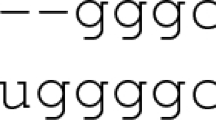Abstract
Overlap graphs occur in computational biology and computer science, and have applications in genome sequencing, string compression, and machine scheduling. Given two strings \(s_{i}\) and \(s_{j}\), their overlap string is defined as the longest string \(v\) such that \(s_{i} = uv\) and \(s_{j} = vw\), for some non empty strings \(u,w\), and its length is called the overlap between these two strings. A weighted directed graph is an overlap graph if there exists a set of strings with one-to-one correspondence to the vertices of the graph, such that each arc weight in the graph equals the overlap between the corresponding strings. In this paper, we characterize the class of overlap graphs, and we present a polynomial time recognition algorithm as a direct consequence. Given a weighted directed graph \(G\), the algorithm constructs a set of strings that has \(G\) as its overlap graph, or decides that this is not possible.


Similar content being viewed by others
Explore related subjects
Discover the latest articles and news from researchers in related subjects, suggested using machine learning.References
Alon N, Cosares S, Hochbaum DS, Shamir R (1989) An algorithm for the detection and construction of monge sequences. Linear Algebra Appl 114115:669–680 ISSN: 0024-3795. Special issue dedicated to Alan J. Hoffman
Barnes ER, Hoffman AJ (1985) On transportation problems with upper bounds on leading rectangles. SIAM J Algebr Discret Methods 6(3):487–496
Blum A, Jiang T, Li M, Tromp J, Yannakakis M (1994) Linear approximation of shortest superstrings. J ACM 41:630–647 ISSN: 0004-5411
Braga MDV, Meidanis J (2002) An algorithm that builds a set of strings given its overlap graph. In Proceedings of the 5th Latin American symposium on theoretical informatics, LATIN ’02, pp 52–63, London, UK, Springer. ISBN: 3-540-43400-3
Czumaj A, Ga̧sieniec L, Piotrów M, Rytter W (1997) Sequential and parallel approximation of shortest superstrings. J Algorithms 23:74–100 ISSN: 0196-6774
Gallant J, Maier D, Storer JA (1980) On finding minimal length superstrings. J Comput Syst Sci 20(1):50–58 ISSN: 0022-0000
Gevezes T, Pitsoulis L (2013) A greedy randomized adaptive search procedure with path relinking for the shortest superstring problem. J Comb Optim ISSN: 1382-6905
Gingeras TR, Milazzo PJ, Sciaky D, Roberts RJ (1979) Computer programs for the assembly of DNA sequences. Nucl Acids Res 7(2):529–543
Gusfield D (1994) Faster implementation of a shortest superstring approximation. Inf Proces Lett 51(5):271–274 ISSN: 0020-0190
Gusfield D, Landau GM, Schieber B (1992) An efficient algorithm for the all pairs suffix–prefix problem. Inf Process Lett 41:181–185 ISSN: 0020-0190
Ilie L, Popescu C (2006) The shortest common superstring problem and viral genome compression. Fundam Inf 73:153–164 ISSN: 0169-2968
Ilie L, Tinta L, Popescu C, Hill KA (2006) Viral genome compression. In: Mao C, Yokomori T (eds) DNA computing, vol 4287 of lecture notes in computer science, pp Springer, Berlin/Heidelberg, pp 111–126
Jenkyns TA (1979) The greedy travelling salesman’s problem. Networks 9(4):363–373 ISSN: 1097-0037
Jiang T, Li M (1994) Approximating shortest superstrings with constraints. Theor Comput Sci 134(2):473–491 ISSN: 0304-3975
Middendorf M (1998) Shortest common superstrings and scheduling with coordinated starting times. Theor Comput Sci 191(1–2):205–214 ISSN: 0304-3975
Shapiro MB (1967) An algorithm for reconstructing protein and RNA sequences. J ACM 14:720–731 ISSN: 0004-5411
Staden Roger (1982) Automation of the computer handling of gel reading data produced by the shotgun method of DNA sequencing. Nucl Acids Res 10(15):4731–4751
Storer JA, Szymanski TG (1982) Data compression via textual substitution. J ACM 29:928–951 ISSN 0004-5411
Tarhio J, Ukkonen E (1988) A greedy approximation algorithm for constructing shortest common superstrings. Theor Comput Sci 57(1):131–145 ISSN: 0304–3975
Acknowledgments
This research has been co-financed by the European Union (European Social Fund—ESF) and Greek national funds through the Operational Program “Education and Lifelong Learning” of the National Strategic Reference Framework (NSRF)—Research Funding Program: Heracleitus II. Investing in knowledge society through the European Social Fund.
Author information
Authors and Affiliations
Corresponding author
Rights and permissions
About this article
Cite this article
Gevezes, T.P., Pitsoulis, L.S. Recognition of overlap graphs. J Comb Optim 28, 25–37 (2014). https://doi.org/10.1007/s10878-013-9663-3
Published:
Issue Date:
DOI: https://doi.org/10.1007/s10878-013-9663-3




